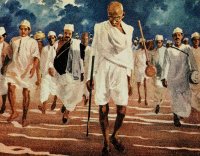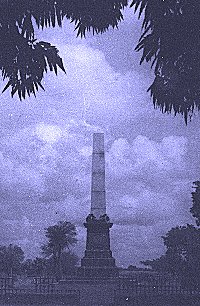The Story of India's Freedom Struggle
Page Last Updated: December 07, 2024
The British came to India to trade but soon found themselves exploiting the inherent divisions in the Indian society (caste, creed, religion) to establish a deep rooted colonial establishment. This is the story of Indians who resisted the British in a nutshell.
The Battle of Plassey
Most historians believe that the colonization of India began with the battle of Plassey in 1757 (See also the Freedom Timeline) when the British defeated Siraj-u-daula. What started as a trade dispute ended up being the English setting up rules and taxes in Bengal.
The Plassey War Memorial Stands today as a painful reminder of humiliation and impoverishment India was to suffer under the British Rule
The British Take Deccan
In years 1766 to 1769 the British constantly harassed the Nawab of Mysore Hyder Ali and forced him into a humiliating agreement. Then in 1784 they encroached his kingdom. But his son Tippu Sultan was a brave soldier and resisted the British till his death in the battlefield in Srirangapattanam.
In 1805, the British defeated the Marathas and set strong foothold in the Deccan.
The Sikh Resistance
The Sikhs established a very strong military under the leadership of Raja Ranjit Singh and ruled an independent and prosperous nation. But soon after Ranjit Singh's death, the British overpowered the Sikhs in 1846. This was to become a crucial win for them during the Sepoy Mutiny that broke out in the subsequent decade.
The Sepoy Mutiny (First Indian War of Independence)
In 1857, the Hindus and Muslims forged a rare unity under the leadership of the Bahadur Shah (who was to become the last Mogul) and fought against the British. Soldiers deserted army and there was large scale violence before the English crushed the resistance.
(For a detailed discussion, see the First Indian War of Independence)
The Indian National Congress

Gandhi Leads Satyagrahis on Salt March
Indian National Congress was founded in 1885 and fought to dislodge the British from the subcontinent. The main movements were Non-cooperation movement in 1920, The Civil Disobedience movement in 1922, The Salt March in 1930 and the Quit India Movement in 1942.
Religious Divide and Partition
Throughout the freedom struggle, Indians had to battle the religious divide and hatred among Hindus and Muslims. Hindu Maha Sabha started in 1923, believed in establishing a Hindu India and resisted Gandhi's Muslim appeasement efforts. The British used this inherent divide among Indians to suppress the Indian freedom movement and eventually divided the nation into a Muslim Pakistan and a secular India.
______________________________
Tryst with destiny
Introduction | Tryst With
Destiny | Brief
History
Sepoy
Mutiny | Indian National
Congress
The People | The Events
![]()
The Story of India's Freedom Struggle
